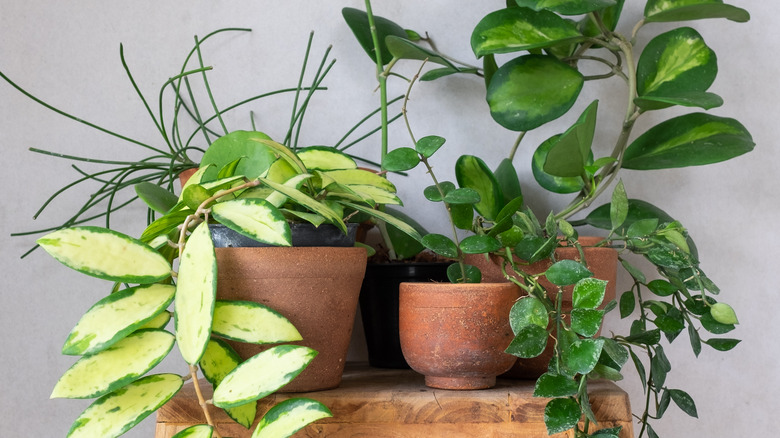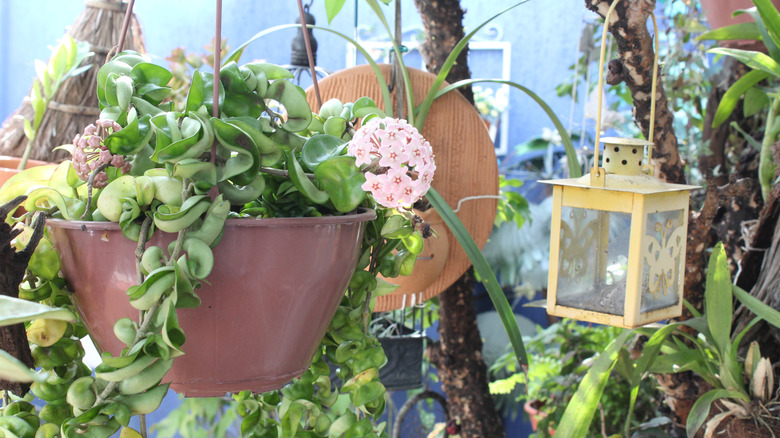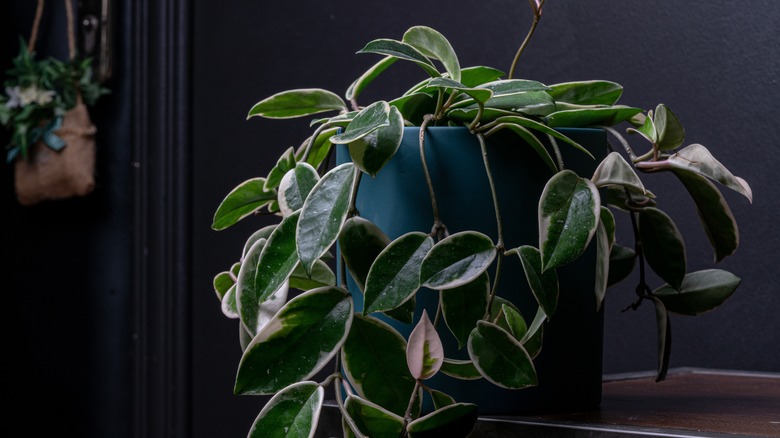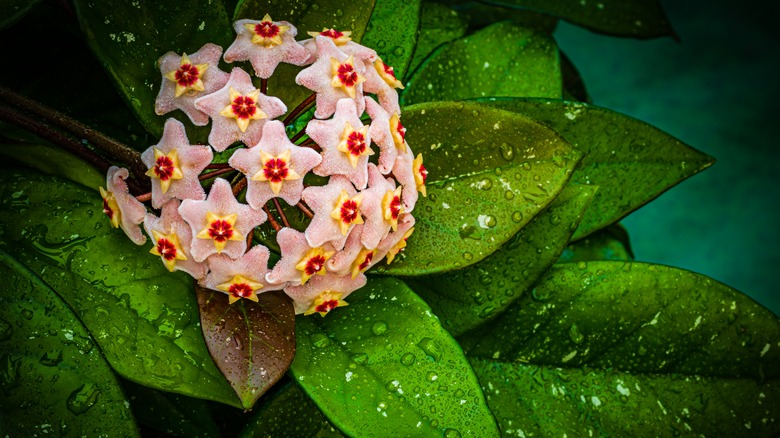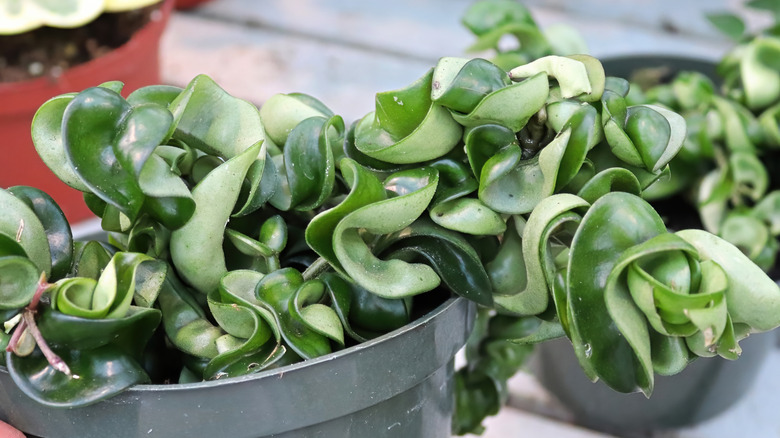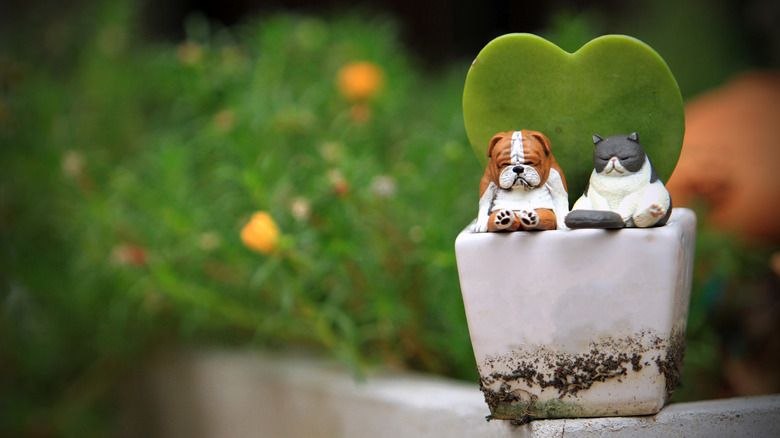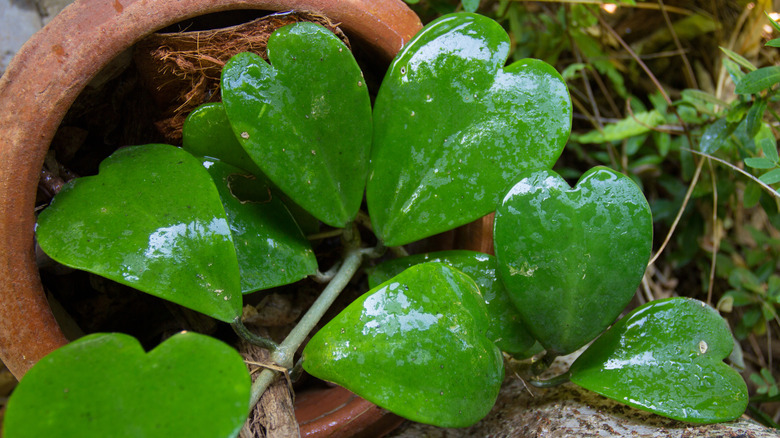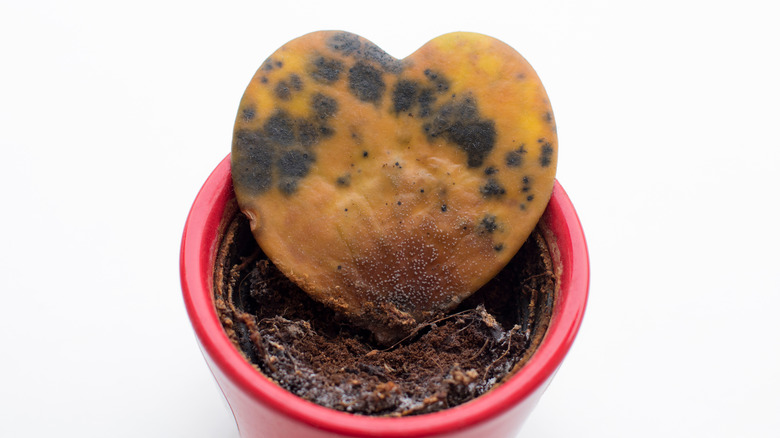Hoya Plants: Everything You Need To Know Before Planting
Hoya is the genus name for an indeterminate number of plant species that are part of the larger Apocynaceae botanical family, which includes milkweeds. Homestead Brooklyn explains that while over 500 species have been named, there could actually be as many as 200 more still unnamed. This is due to the fact that in the wild they grow on treetops as epiphytes and are, therefore, difficult to discover. Hoyas are tropical in origin but can be found all over the world as a very popular houseplant. According to GardenersWorld.com, the Hoya carnosa is the most common species in the genus with waxy deep green foliage and white flower clusters that emit their strongest scent at night. Other species may have pink flowers, variegated leaves, and different overall shapes and growth patterns.
Homestead Brooklyn adds that hoyas and their delicate blooms are usually referred to as wax plants and porcelain flowers. Some hoyas are vining climbers, others hang like pendants, while some varieties can be bushier and look more like shrubs. A few may be more difficult to grow than others, but for the most part, hoyas are easy to care for and thrive in very similar environmental conditions.
How to use in garden
Hoyas are very common indoor houseplants, but they're not particularly suited for planting in the ground as part of a garden or landscape. On the other hand, they can spruce up a covered porch or patio where the most common way to display them is in hanging baskets. The height of the hangers allows for their tendrils to cascade down on all sides, which look exquisite when in bloom. Other placement options are up high on a shelf or along a railing.
When scoping out the best location to install a hook for your outdoor hoya, first look for where its most important environmental conditions will be met. In this case, that means warm temperatures that never go below 45 degrees Fahrenheit and bright natural light, notes IFAS Gardening Solutions at the University of Florida. It's important to understand that bright light does not equate to scorching sun exposure. Unfortunately, direct sun is likely to burn the leaves and damage the plant. To ensure a happy hoya, Joy Us Garden says to think bright yet sheltered. Covered porches with indirect sunlight peeking in from the eastern, western, and northern sides are ideal for this. If your patio is uncovered and fully exposed, move out into the yard and consider hanging your hoya basket from a tree branch. Strategically placed outdoor lights can lend a fairytale effect to the area at nighttime when the delightful fragrance of the Hoya carnosa is at its peak.
How to grow hoya plants
Hoyas are undoubtedly the kind of plant you fall in love with, so it's little wonder that people are excited to grow and care for them. Hoyas can be propagated by seed, but a much easier method is taking stem cuttings and leaving them to root in water. Everything Plants, via their YouTube channel, shows exactly where to make the cut. Always use clean and sterile cutting shears to avoid spreading diseases. Pick a leafy tendril and cut a long piece right after a leaf node close to its base. With this long piece in hand, work your way along the vine making cuts at each leaf point. Each piece is called a single leaf cut and will be only a few inches long.
Next up, fill a shallow jar with water and insert the stems so that the cut ends are in the water and the leaves are draping over the top of the jar. Move the jar to a location that receives plenty of bright light, and before too long you should see roots growing out from the stems. Once they are looking healthy and viable, you can plant your rooted cuttings in a growing medium and find your new plants a more permanent home.
How to care for hoya plants
A well-cared-for hoya is much more than a shiny, thick-leafed, evergreen houseplant hanging by the window. Once they've reached maturity, these plants have the potential to produce absolutely divine clusters of deliciously scented, tiny, picture-perfect flowers in shades of pink or white. Hoya care revolves primarily around appropriate light exposure and proper watering. Because they have semi-succulent or succulent leaves, depending on the species, Platt Hill Nursery strongly recommends waiting until the soil has become completely dry before its next watering. They even go so far as to say you can let your plant dry out until you see a bit of wrinkling on the leaves. At that point, water thoroughly, checking for drainage and emptying trays of any unused water.
Hoyas should not be subjected to deadheading. This is important because over time your hoya plant is going to continue to bloom from the same exact part of the plant, which is called a peduncle (via IFAS Gardening Solutions). So, be gentle and keep those peduncles safe. If your mature plant has yet to flower, move it to an area where it will receive more light, such as closer to a sunny window.
Hoya plant varieties
Hoya carnosa is the most popular variety, but with hundreds of species to choose from, you've got some other very cool options to choose from. Let's narrow it down to a few that you will most likely be able to find at your local nursery.
- Hoya carnosa variegata tricolor is the same easy-to-care-for hoya you know and love, but with a twist. The variegated leaves are edged with white, and the stems are a luscious shade of dark pink.
- Hoya carnosa compacta (pictured above) is known as the Hindu rope plant or the krinkle kurl. This slow-grower stretches out like a twisted rope and requires an extensive amount of humidity to stay healthy.
- Hoya obovata gets its name because of its oval-shaped leaves that look like they've been splattered with white paint.
- Hoya carnosa rubra is nicknamed the krimson princess and it lives up to that name. The rubra's triangle-shaped leaves have variegation patterns that appear in the middle. They can be white or pink surrounded by shades of light and dark green. And you will not be disappointed by this hoya's light pink flowers with dark pink centers.
Finally, there's the thick-leafed, thick-stemmed hoya kerrii, or sweetheart hoya. Per Our House Plants, the heart-shaped leaves of this delightful little plant are why it's sometimes also called the Valentine plant. It is an exceptionally slow-growing plant that has become popular when sold as a single heart leaf in a tiny pot.
Are hoya plants toxic?
All varieties of hoya plants are classified as safe and non-toxic by the ASPCA and Pet Care Advisors, with only a small possibility for mild skin irritation should any part come into contact with the sap. There are still some commonsense guidelines to keep in mind when maintaining houseplants in the company of pets. Any plant that is consumed in abundance can cause gastrointestinal upset in the forms of stomachache, mild vomiting, or diarrhea. This is especially true for cats because they are true carnivores and, therefore, cannot digest foliage (per Pet Care Advisors). An article in the Plant Week section of New York Magazine also points out that even if the houseplant itself is non-toxic, it's possible that the fertilizer contained in its soil is poisonous. It's a sensible idea to keep all houseplants out of the reach of curious noses. This could mean keeping them on high shelves or hanging them in baskets, which we already know to be fantastic options for hoyas.
How to repot hoya plants
Hoyas are a bit peculiar in that they tend to be quite happy when they are relatively root-bound. According to Pistils Nursery, they are even known to produce more flower clusters when in that state. Downsizing to a smaller pot is not recommended as a way to encourage blossoms, but this does all mean that a well-cared-for plant should be able to live in the same pot for many years without needing to be repotted.
Of course, there may be other reasons why you need to repot your hoya. Perhaps you're moving it to a different area or changing up the décor around your home. In this case, be careful when moving an established hoya. Homestead Brooklyn notes that the hanging tendrils like to wind themselves around whatever is nearby and can become entangled among neighboring plants. Unwind them with care. Since hoyas prefer a quick-drying soil environment, porous terracotta pots make a great option for a new container. Also make sure your new potting mixture has plenty of bark, perlite, or coco chips mixed in. Water thoroughly after repotting, then let the potting mix dry out completely before watering it thoroughly again.
Common mistakes and issues with hoya plants
Overall, hoyas are well-loved houseplants because they are relatively easy to care for and can live for many years. However, there are a few mistakes that absolutely must be avoided in order for this to happen smoothly. Overwatering or not providing a growing medium or container that sufficiently drains is one of the biggest. Hoyas need to be adequately watered, but they cannot tolerate standing water or moist soil. Stamen and Stem state that insufficient drainage is a serious problem that can cause root rot. If your plant is suffering, this is the first thing to look for. Furthermore, Bloomscape explains that overwatering can cause the leaves of your hoya to turn brown or yellow and drop or die off prematurely. Lack of light can also be the reason behind yellow leaves.
On the other hand, extremely dry conditions, leaving your plant unattended for too long, and low humidity can also harm a hoya. Most likely this sort of damage will be in the form of wrinkled leaves and the cure may just be a long soak. Try placing your plant, pot and all, for a half-hour or so in a sink with a few inches of water. Additionally, according to Omysa, hoyas often require neem oil or insecticidal soap to ward off common pests such as mealy bugs, aphids, and spider mites.
